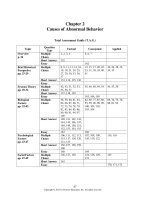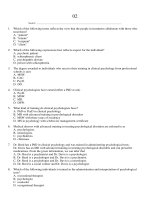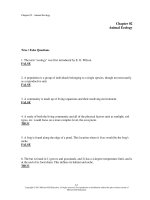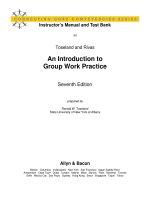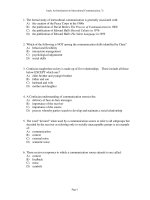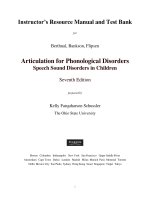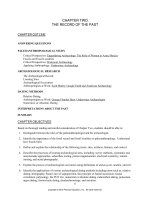Abnormal psychology clinical perspectives on psychological disorders 7th edition whitbourne test bank
Bạn đang xem bản rút gọn của tài liệu. Xem và tải ngay bản đầy đủ của tài liệu tại đây (466.46 KB, 43 trang )
02
Student: ___________________________________________________________________________
1.
Which of the following terms reflects the view that the people in treatment collaborate with those who
treat them?
A. "patient"
B. "inmate"
C. "recipient"
D. "client"
2.
Which of the following expressions best reflects respect for the individual?
A. psychotic patient
B. schizophrenic client
C. psychopathic deviate
D. person with schizophrenia
3.
The degree awarded to individuals who receive their training in clinical psychology from professional
schools is a(n)
A. MSW.
B. CAC.
C. PsyD.
D. DO.
4.
Clinical psychologists have earned either a PhD or a(n)
A. PsyD.
B. MSW.
C. MD.
D. DSW.
5.
What kind of training do clinical psychologists have?
A. PhD or PsyD in clinical psychology
B. MD with advanced training in psychological disorders
C. MSW with three years of residency
D. MS in psychology with a behavior management certificate
6.
Medical doctors with advanced training in treating psychological disorders are referred to as
A. psychologists.
B. neurologists.
C. psychiatrists.
D. clinicians.
7.
Dr. Reed has a PhD in clinical psychology and was trained in administering psychological tests.
Dr. Davis has an MD with advanced training in treating psychological disorders and can prescribe
medications. From the given information, we can infer that
A. Dr. Reed is a psychiatrist and Dr. Davis is a psychologist.
B. Dr. Reed is a psychologist and Dr. Davis is a psychiatrist.
C. Dr. Reed is a psychologist and Dr. Davis is a neurologist.
D. Dr. Reed is a social worker and Dr. Davis is a psychologist.
8.
Which of the following individuals is trained in the administration and interpretation of psychological
tests?
A. recreational therapist
B. psychologist
C. counselor
D. occupational therapist
9.
A mental health professional with training in the behavioral sciences who provides direct service to
clients is known as a(n)
A. psychiatrist.
B. occupational therapist.
C. clinical psychologist.
D. clinician.
10. Which of the following is an individual without a graduate-level training in psychology who can also play
a critical role in mental health services?
A. family therapist
B. recreational therapist
C. counseling psychologist
D. psychiatrist
11. The publication that contains descriptions of the various psychological disorders is called the
A. International Manual of Mental Diseases.
B. Physicians' Desk Reference.
C. Diagnostic and Statistical Manual of Mental Disorders.
D. American Psychological Association's Mental Disorders Handbook.
12. The consistency of measurements or diagnoses is referred to as
A. reliability.
B. validity.
C. the base rate.
D. a correlation.
13. Ralph has been sad and listless for three years. He cannot sleep and has lost his appetite. Using a
diagnostic system, one clinician arrives at a diagnosis of depression. Using the exact same diagnostic
system, another clinician arrives at a diagnosis of schizophrenia. What is the problem with this system?
A.
B.
C.
D.
It lacks effectiveness.
It lacks universality.
It lacks reliability.
It lacks validity.
14. Which of the following refers to the extent to which a diagnosis or rating accurately characterizes a
person's psychological status?
A. reliability
B. validity
C. precision
D. significance
15. The purpose of a diagnostic manual is to provide
A. consistent diagnoses across people based on the presence or absence of a set of specific symptoms.
B. a clinician with a statistical model derived from data of different patients.
C. a list of names and contacts of mental patients who have been correctly diagnosed and successfully
treated.
D. elaborate studies and documents of mentally retarded patients who have also had physical disabilities.
16. Which of the following questions best describes one of the critical debates that will shape the new DSM5?
A. Is the DSM too inclusive of conditions that are known to be medical in nature?
B. Are the terms "disease", "illness", and "disorder" biomedical terms or sociopolitical terms?
C. Should the categorical approach be abandoned in favor of a dimensional approach?
D. Should the term "insanity" be included in the new edition of the DSM?
17. The diagnoses contained in the current DSM-IV-TR more closely correspond to those included in the
A. Physician's Desk Reference.
B. International Manual of Mental Diseases.
C. DSM-II.
D. International Classification of Diseases.
18. An axis is a class of information in DSM-IV regarding
A. one aspect of an individual's functioning.
B. a list of individuals suffering from schizophrenia.
C. the treatment of physical disabilities.
D. the number of cases pending with incorrect diagnosis.
19. The notion that disorders involving a loss of identity fit into a distinct group separate from other disorders
is the essence behind the
A. statistical approach.
B. psychodynamic model.
C. categorical approach.
D. dimensional model.
20. Dr. Johnson believes that the frequency and intensity of compulsive behavior exists on a continuum from
mild to severe. Dr. Johnson prefers to use which approach when viewing this behavior?
A. categorical
B. dimensional
C. psychoanalytical
D. statistical
21. The DSM-IV-TR adheres to the
A. psychoanalytic model.
B. behavioral model.
C. societal model.
D. medical model.
22. The fact that many clinicians view alcoholism as a disease is consistent with the DSM-IV-TR assumption
that classification should be based on the
A. psychogenic model.
B. humanitarian model.
C. medical model.
D. multimodal model.
23. A clinically significant behavioral or psychological syndrome that occurs in a person and is associated
with present distress, disability, or increased risk of suffering is defined in the DSM-IV-TR as a
A. disease.
B. psychological disability.
C. mental disorder.
D. neurological dysfunction.
24. The number of axes the DSM-IV-TR utilizes along which clients are evaluated is
A. 2
B. 5
C. 7
D. 10
25. A collection of symptoms that together constitute a particular psychological disorder is a(n)
A. diagnosis.
B. syndrome.
C. prognosis.
D. axis.
26. "Coughing, sniffling, sneezing, runny nose, achiness, scratchy throat, and inability to sleep." This
collection of symptoms represents a(n)
A. association.
B. diagnosis.
C. prognosis.
D. syndrome.
27. Which of the following is NOT a component of the definition of a mental disorder included in the DSMIV-TR?
A. The disorder is reflected in a behavioral or psychological syndrome.
B. The disorder is associated with present distress.
C. The disorder is an expectable and culturally sanctioned response.
D. The disorder is associated with impairment in life.
28. A man arrives one hour late for work every day because he is compelled to read every street sign on the
road to his workplace. Which of the following components of a mental disorder is exemplified by this
scenario?
A. behavioral syndrome
B. impairment in life
C. impulse-control
D. anxiety
29. Which of the following is a somatoform disorder?
A. hypochondriasis
B. pedophilia
C. anorexia nervosa
D. kleptomania
30. Disorders in which the normal integration of consciousness, memory, sense of self, or perception is
disrupted are known as
A. adjustment disorders.
B. anxiety disorders.
C. dissociative disorders.
D. impulse-control disorders.
31. Jack believes he is Jesus Christ and that he can walk on water. He claims he hears God talking to him
every morning at 3:00 a.m. In general terms, Jack seems to be suffering from
A. neurosis.
B. psychosis.
C. hypochondriasis.
D. prognosis.
32. Which of the following terms is used to refer to various forms of behavior that involve disturbed sleep
patterns?
A. depression
B. neurosis
C. delusion
D. insomnia
33. Which of the following disorders is characterized by disruption of normal integration of consciousness or
perception?
A. dissociative disorder
B. bipolar disorder
C. somatoform disorder
D. major depression
34. Which of the following is characterized by a consistently sad mood?
A. manic-depression
B. bipolar disorder
C. schizophrenia
D. major depression
35. The disorders which involve impairment in thought processes caused by medical conditions are
called
A. amnestic disorders.
B. psychotic disorders.
C. schizophrenic disorders.
D. prognostic disorders.
36. Which of the following terms is NOT used in the DSM-IV-TR?
A. bipolar disorder
B. major depression
C. schizophrenia
D. neurosis
37. Conditions characterized by the development of emotional and behavioural symptoms within 3 months
after a clear stressor are called
A. clinical disorders.
B. somatoform disorders.
C. cognitive disorders.
D. adjustment disorders.
38. The potential loss of his job has caused RJ to become deeply despondent. For the past six months, he has
begun drinking heavily and spending money irresponsibly. RJ is likely to be diagnosed with a(n)
A. impulse control disorder.
B. personality disorder.
C. adjustment disorder.
D. clinical disorder.
39. What information led Dr. Tobin to conclude that Peter was suffering from bipolar disorder?
A. Peter reported having intense bouts of anxiety.
B. Peter recently married but divorced three months later.
C. Peter experienced a psychotic episode after losing his job.
D. Peter was in a period of elation but had previously experienced a period of depression.
40. Which of the following disorders belongs to Axis I in DSM-IV-TR?
A. antisocial personality disorder
B. mood disorder
C. stress disorder
D. culture-bound disorder
41. Clinical disorders are listed on which axis in a DSM-IV-TR diagnosis?
A. Axis I
B. Axis III
C. Axis IV
D. Axis V
42. Schizophrenia and major depression are classified on
A. Axis I of the DSM-IV-TR.
B. Axis II of the DSM-IV-TR.
C. Axis III of the DSM-IV-TR.
D. Axis IV of the DSM-IV-TR.
43. Elaine is suffering from an anxiety disorder. She is classified as having an
A. Axis I disorder.
B. Axis II disorder.
C. Axis III disorder.
D. Axis IV disorder.
44. Susan and Ron are having marital difficulties; their difficulties are not due to any long-standing
psychological problems. A clinician might document their difficulties by
A. diagnosing each as having a personality disorder.
B. diagnosing each as having an adjustment disorder.
C. only listing the information on Axis IV.
D. considering the problem as a part of Axis I.
45. Axis II of the DSM-IV-TR is used for
A. clinical disorders.
B. personality disorders and mental retardation.
C. organic brain disorders.
D. substance abuse disorders.
46. Joey is diagnosed as having mental retardation. Which DSM-IV-TR Axis does this diagnosis appear on?
A.
B.
C.
D.
III
IV
V
II
47. Which disorders are built into the fabric of an individual's personality or behavior patterns?
A. Axis IV disorders
B. Axis II disorders
C. Axis III disorders
D. Axis V disorders
48. Which DSM-IV-TR Axis is reserved for information about physical conditions that may be the basis of a
client's emotional problems?
A. Axis V
B. Axis IV
C. Axis I
D. Axis III
49. Kathy was diagnosed with breast cancer three months ago and is now reporting feelings of severe
depression. On what DSM-IV-TR Axis would the information about her medical condition be recorded?
A.
B.
C.
D.
Axis I
Axis II
Axis III
Axis IV
50. Cheryl's high blood pressure is aggravated by her persistent obsession with cleanliness. On which axis
would information regarding her medical condition appear?
A. Axis I
B. Axis III
C. Axis IV
D. Axis V
51. A psychologist suspects that Dan's psychotic episode may be related to the recent death of his wife. On
which DSM-IV-TR Axis would this stressful event be recorded?
A. Axis I
B. Axis II
C. Axis III
D. Axis IV
52. The likelihood of a client recovering from a disorder is referred to as his or her
A. prognosis.
B. diagnosis.
C. convalescence.
D. determination.
53. On which DSM-IV-TR Axis is information listed about the client's global level of functioning at the time
he or she is seen by the clinician?
A. Axis I
B. Axis II
C. Axis IV
D. Axis V
54. Heather has been diagnosed as having schizophrenia. Six months ago Heather's symptoms were rather
mild but now they are severe. On which Axis would this information appear in a DSM-IV-TR diagnosis?
A.
B.
C.
D.
Axis IV
Axis VI
Axis V
Axis III
55. Mrs. Waltham is 75 years old and has been brought in for treatment by her daughter. Her daughter
claims that Mrs. Waltham has not only become forgetful, but has begun fabricating stories about how
she is a Bavarian princess who must return to her homeland to help the king. The clinician automatically
diagnoses Mrs. Waltham as having schizophrenia. What important information has the clinician
obviously ignored in making this diagnosis?
A. occupational status
B. client's age
C. prevalence of this disorder
D. client's gender
56. The Global Assessment of Functioning (GAF) scale is the basis for
A. Axis I.
B. Axis III.
C. Axis IV.
D. Axis V.
57. A GAF scale of 11-20 of an individual's psychological health indicates
A. persistent danger to self.
B. a superior functioning.
C. slight passing symptoms.
D. serious impairment.
58. The first step for a clinician in the diagnostic process involves
A. ruling out differential diagnoses.
B. planning a treatment strategy.
C. reviewing the DSM criteria for disorders matching the client's symptoms.
D. commencing the treatment program.
59. According to the original National Comorbidity Survey, which of the following types of disorders was
most commonly comorbid with other psychiatric diagnoses?
A. the schizophrenias
B. drug and alcohol abuse
C. anxiety disorders
D. mood disorders
60. The original National Comorbidity Survey revealed that of those individuals with a lifetime history of
psychological disorders, the percentage of individuals who suffer from multiple conditions is about
A. 10.
B. 40.
C. 50.
D. 80.
61. Multiple diagnostic conditions that occur simultaneously within the same individual are referred to as
A. comorbid disorders.
B. culture-bound syndromes.
C. differential diagnoses.
D. primary diagnoses.
62. Martin was recently diagnosed with bipolar disorder. He has also struggled for years with alcoholism,
so in addition to his therapy sessions, his therapist recommends that he attend Alcoholics Anonymous
meetings. Based on this information, we can say that Martin
A. has an impulse-control disorder.
B. has a somatoform disorder.
C. has comorbid psychiatric conditions.
D. has a therapist who works in a CMHC.
63. The process of ruling out possible alternative diagnoses is called a(n)
A. differential diagnosis.
B. compound diagnosis.
C. assessment of functioning.
D. multiaxial diagnosis.
64. Dr. Richards is treating Joey who is suffering from extreme anxiety. Dr. Richards finds that his patient's
symptoms could also be suggestive of a substance-abuse disorder or a serious impulse-control problem.
In this case, Dr. Richards should
A. consider a principal diagnosis treatment.
B. undertake a differential diagnosis treatment.
C. transfer Joey to a halfway house.
D. declare a simple case of dissociative identity disorder.
65. Robert has a serious drinking problem. His therapist feels that the drinking is a result of Robert's constant
bouts with depression. Based on this information, what would the principal diagnosis be?
A. alcoholism
B. bipolar disorder
C. degenerative dementia
D. major depression
66. An analysis of the client's development and the factors that may have influenced the client's current
emotional state is called a
A. diagnosis.
B. prognosis.
C. classification.
D. case formulation.
67. Dr. Burns is analyzing his client's personal history in an attempt to identify the factors that may have
produced his psychotic behavior. Dr. Burns is creating a(n)
A. assessment of global functioning.
B. final diagnosis.
C. case formulation.
D. treatment regimen.
68. Jenny has received a diagnosis of major depression. What might give you a more complete picture of this
client's condition?
A. a primary diagnosis
B. her case formulation
C. her long-term prognosis
D. the clinician's theoretical perspective
69. Recurrent patterns of abnormal behavior that are limited to specific societies or cultural areas are defined
as
A. mood disorders.
B. comorbid disorders.
C. culture-bound syndromes.
D. sociocultural criteria.
70. Mr. Kang, a recent immigrant from China, is overwhelmed and distressed by the untimely death of
his wife. His co-workers are concerned about his mental health because he believes he is in constant
contact with her and can be seen talking to her on a regular basis. It is not likely that Mr. Kang would be
diagnosed as having a mental disorder because his behavior
A. is an acceptable and culturally sanctioned response in his particular culture.
B. reflects a documented behavioral/psychological syndrome.
C. is not associated with his present distress and impairment.
D. cannot be explained using the medical model.
71. Sangue dormido, or "sleeping blood", is a condition observed among individuals from the Cape Verde
Islands and involves paralysis, convulsions, blindness, and tremors. This condition is referred to in the
DSM-IV-TR as a(n)
A. adjustment disorder.
B. clinical syndrome.
C. general medical condition.
D. culture-bound syndrome.
72. Which of the following is true?
A. Psychologists are in the business of handing out medication.
B. Louisiana became the first state to approve prescription privileges to psychologists.
C. Homicidal behavior can be attributed to a culture-bound syndrome.
D. Therapeutic work is effective only if the client has almost fully recovered.
73. Which of the following supports the argument in favor of prescription privileges for psychologists?
A. Psychiatrists receive medical training unlike psychologists.
B. Psychologists work as a team with psychiatrists to deal with disorders like schizophrenia.
C. Normal physicians have a broader knowledge base than psychologists.
D. Psychologists can integrate medication into psychotherapy.
74. The outline for how therapy should take place is known as
A. the treatment plan.
B. the case formulation.
C. the primary diagnosis.
D. psychoanalytic treatment.
75. Which of the following is the proper sequence for treating a client's condition?
A. short-term goals, immediate management, long-term goals
B. long-term goals, short-term goals, immediate management
C. immediate management, long-term goals, short-term goals
D. immediate management, short-term goals, long-term goals
76. Which of the following is an immediate goal in treatment planning of a client who is severely depressed?
A.
B.
C.
D.
establish a working relationship between the clinician and the client
admit the client into a mental hospital
develop a strategy for coping with the symptoms
take the client off the medication
77. Donna's clinician has recommended electroconvulsive therapy in an attempt to control her drastic suicidal
impulses. What stage of treatment is she in?
A. immediate management
B. assessment of objectives
C. assessment of current functioning
D. formulation of development strategy
78. Roger is in the stage of therapy where he and his therapist are working on altering his long-standing
patterns of dependent behavior. What phase of therapy is Roger in?
A. immediate management
B. assessment of objectives
C. management of short-term goals
D. management of long-term goals
79. After a final diagnosis is made and a case formulation is constructed, what is the next step in treating a
client?
A. administration of medication
B. deciding on a treatment site
C. evaluation of the therapeutic outcome
D. designing a treatment plan
80. If a client needs intensive supervision, but not actual hospital care, a clinician might suggest a
A. community mental health center (CMHC).
B. halfway house.
C. psychiatric hospital.
D. specialized inpatient treatment center.
81. What treatment site is usually recommended by a clinician when clients present a risk of harming
themselves or others?
A. community mental health center
B. psychiatric hospital
C. halfway house
D. outpatient treatment center
82. An outpatient clinic that provides psychological services on a sliding fee scale and serves individuals who
live in a certain geographic region is called a(n)
A. halfway house.
B. psychiatric hospital.
C. community mental health center.
D. asylum.
83. Which of the following treatment sites are recommended by clinicians for children who need constant
monitoring due to severe behavioral disturbances?
A. specialized inpatient treatment centers
B. outpatient treatment centers
C. psychiatric hospitals
D. halfway houses
84. Rob is receiving treatment for his psychological disorder from a private therapist in his neighbourhood. It
is most likely that Rob is going to a
A. community mental health center.
B. halfway house.
C. psychiatric hospital.
D. psychoanalytic institute.
85. Deinstitutionalized clients coming out of the hospital who are not yet ready for independent living often
move into
A. CMHCs.
B. psychiatric hospitals.
C. outpatient clinics.
D. halfway houses.
86. Structured programs in a community treatment facility that provide activities similar to those provided in
a psychiatric hospital are called
A. day treatment programs.
B. employee assistance programs.
C. assertive community treatment.
D. recovery programs.
87. Michelle, who is recovering from schizophrenia, is being released from the psychiatric hospital because
her symptoms are under control. Michelle's living skills, however, are still inadequate since she has been
institutionalized for quite some time. What will her therapist most likely suggest?
A. placement in an asylum
B. readmission to the psychiatric hospital
C. placement in a halfway house
D. admission to a sanitarium
88. James is a person with schizophrenia who has delusions that the CIA is after him. He has been brought to
a psychologist by the police after being arrested for assaulting an elderly woman whom he claimed was
trying to kill him. Assuming that testing reveals that he truly is psychotic, where will the psychologist
recommend that he be sent?
A. a CMHC
B. a day treatment program
C. a halfway house
D. a psychiatric hospital
89. Programs which provide confidential settings in the workplace where individuals can seek treatment in
the form of counseling, assistance with substance abuse, and family treatment are known as
A. employee assistance programs.
B. day treatment programs.
C. unemployment benefit programs.
D. special employee programs.
90. David is a junior at the local high school. The school's administration believes that his recent emotional
outbursts during class may be due to problems in his home life. Who might be best suited to deal with
this situation?
A. the principal
B. a guidance counselor
C. a psychiatrist
D. an EAP counselor
91. The form in which psychotherapy is offered (e.g., individual psychotherapy versus group therapy) is
referred to as its
A. modality.
B. milieu.
C. mechanism.
D. delivery mode.
92. Shelley is being treated by a therapist along with her parents and siblings. Which form of therapy is this
most likely to be?
A. group therapy
B. family therapy
C. milieu therapy
D. social therapy
93. Which of the following treatment processes is specific to psychiatric hospitals and is based on the
premise that the environment is a major component of the treatment?
A. group therapy
B. traditional psychotherapy
C. family therapy
D. milieu therapy
94. A treatment approach used in an inpatient psychiatric facility in which all facets of the environment are
components of the treatment is referred to as
A. psychoanalytic therapy.
B. person-centered therapy.
C. milieu therapy.
D. group therapy.
95. Shelly meets twice a week with a number of individuals who have problems similar to hers. They openly
share their problems with others in a trusting, receptive environment which also facilitates improvement
of their interpersonal skills. Shelly is participating in
A. milieu therapy.
B. group therapy.
C. dynamic therapy.
D. social therapy.
96. Ryan has been in trouble with the law for shoplifting and vandalism. His therapist has asked that Ryan's
family participate in his therapy sessions. What therapy modality is Ryan's therapist employing?
A. group therapy
B. family therapy
C. milieu therapy
D. dynamic therapy
97. What is the current trend with regard to theoretical perspectives and treatment of psychological disorders?
A.
B.
C.
D.
the person-centered theory
the psychodynamic theory
the object relations theory
the combination of elements from various orientations
98. Integration of the best available proof offered by research and clinical expertise in the context of a client's
life characterizes
A. evidence-based practice in psychology.
B. the results of the Epidemiological Catchment Area study.
C. the results of the National Comorbidity Survey.
D. data on the prevalence of disorders in minority populations.
99. Clinical decision-making that integrates the best available research evidence and clinical expertise in the
context of the cultural background, preferences, and characteristics of clients is called
A. comorbid decision-making.
B. evidence-based practice in psychology.
C. integrative expertise.
D. combinatory thinking.
100.The idea that clinicians should adapt their knowledge of state-of-the-art research findings to different
clients' particular backgrounds, needs, and prior experiences is called
A. integrative choice in psychology.
B. the adaptation model.
C. evidence-based practice in psychology.
D. mental health parity.
101.Dr. Patel likes to stay on the cutting edge of research in her psychotherapy practice. She also feels
strongly about recognizing the influences of a client's cultural background, personal preferences, and
characteristics on the therapy process. We refer to clinical decision-making that takes all of these areas
under consideration as
A. adaptation therapy.
B. evidence-based practice.
C. combinatory counseling.
D. concatenation counseling.
102.Which of the following is NOT a role of a good clinician while treating his/her client?
A. to infuse a deep personal interest in the matter
B. to show a sense of respect toward the problem of the client
C. to judge the present condition by taking into account all available information regarding the client
D. to forcefully insert his/her own thoughts regarding the issue into the client's mind
103.What is the most crucial determinant of whether or not therapy will succeed?
A. the clinician's theoretical perspective
B. the severity of the client's problem
C. the quality of the client-clinician relationship
D. the duration of the client's symptoms
104.Which of the following is one of the skills that a clinician develops to provide insight into the nature of a
client's problems?
A. the ability to interpret the results of physiological assessments
B. the ability to determine a client's underlying motives for seeking treatment
C. the ability to determine whether or not a client is lying
D. the ability to scan the client-clinician interaction for cues
105.Which of the following types of information are people LEAST comfortable revealing to professionals?
A.
B.
C.
D.
emotional
financial
legal
medical
106.Brian is a high-school student and has suffered major depression in the last six months. If a psychiatrist
is consulted at this time, it is likely that Brian will face most difficulty in revealing the reason for his
depression which is largely due to the separation of his parents because of:
A. the financial nature of his problem.
B. legal implications.
C. the emotional nature of his problem.
D. technical complications.
107.Despite the best treatment some patients seem unwilling to change because
A. most of the time clinicians fail to make a proper primary diagnosis.
B. chances are that they have become accustomed to living with their symptoms.
C. recent data reveals that short-term goals are more successfully achieved than long-term goals of
treatment.
D. modern medical science is not equipped to deal with major mental disorders.
108.Occupational therapists are professionals with a master's degree in psychology.
True False
109.A new proposal for the DSM-5 is to create a dual diagnostic system to be used by clinicians and
researchers.
True False
110.Current diagnostic manuals are based on statistical research and findings.
True False
111.Mental retardation falls under Axis II of the DSM-IV-TR.
True False
112.The American Psychiatric Association has revised the DSM because of reliability and validity
difficulties.
True False
113.Axis IV provides a place for the clinician to document events.
True False
114.The DSM-IV-TR utilizes a categorical approach to define mental disorders.
True False
115.The term "prognosis" is not used by mental health professionals anymore.
True False
116.According to Axis IV of DSM-IV-TR, death of a significant family member is an example of problems
with a primary support group.
True False
117.According to the Global Assessment of Functioning Scale (GAF), a rating of 80-90 means an individual
has suicidal tendencies.
True False
118.A cultural formulation is developed when the client has a culturally diverse background.
True False
119.When planning a treatment, it is important to consider the short-term goals of therapy first.
True False
120.Community mental health centers are inpatient clinics that provide psychological services on a sliding fee
scale.
True False
121.Today, clinicians typically combine the best elements of various theoretical perspectives when treating a
client's illness rather than adhering to one particular theoretical model.
True False
122.In family therapy, the clinician identifies the person in the concerned family as the "patient".
True False
123.Strict use of evidence-based treatments will invariably result in desired therapeutic outcomes.
True False
124.The client must be willing to open up and share extremely personal and detailed information with the
clinician if therapy is to succeed.
True False
125.Match the term with the appropriate definition or description.
1. Prognosi
the consistency of measurements or diagnoses _
s
__
_
2. Psychoti
a collection of symptoms that together form a definable _
c disorder
pattern __
_
3. Case
term used to refer to various forms of behavior involving a _
formulation
loss of contact with reality __
_
4. Axis I
disorders involving disturbed sleep patterns _
__
_
5. Axis V
reserved for clinical syndromes _
__
_
6. Reliabilit
reserved for global assessment of functioning rating _
y
__
_
7. Diff
the likelihood of a client recovering from a disorder _
erential
__
diagnosis
_
8. Halfway
the process of ruling out possible alternative diagnoses _
house
__
_
9. Insomnia
an analysis of the client's development and the factors that _
might have influenced his or her current status __
_
10. Syndro
setting designed for those clients who have been discharged _
me
from psychiatric facilities who are not yet ready for independent__
living _
126.Match the term with the appropriate definition or description.
1. Community
medical doctor with advanced training in treating __
mental health center
people with psychological disorders __
2. Validity
diagnoses that represent real and distinct __
phenomena __
3. Adjustment
the result of a reaction to life events that are more __
disorder
extreme than would be expected __
4. Culture-bound
the extent to which psychiatric disorders coexist __
syndromes
__
5. Milieu therapy
reserved for general medical conditions __
__
6. Axis IV
reserved for psychosocial/environmental stressors __
__
7. Comorbidity
recurrent patterns of abnormal behavior limited to __
specific societies __
8. Axis III
outpatient clinic which provides services on a __
sliding scale __
9. Psychiatrist
the provision of an environment where a team of __
professionals works with the client __
127.A person seeking psychological treatment is known as a _____.
________________________________________
128.When diagnoses represent real and distinct clinical phenomena, they are said to have _____.
________________________________________
129.Reactions to life events that are more extreme than normally expected are referred to as _____
disorders.
________________________________________
130.Axis III is reserved for information on any _____ that the client might have.
________________________________________
131.A rating of the individual's overall level of psychological heath is made using the _____ scale.
________________________________________
132.Conditions that are specific to certain cultures are referred to as _____ syndromes.
________________________________________
133.Psychiatric disorders are said to be _____ when a client has two or more at the same time.
________________________________________
134.Programs designed for formerly hospitalized patients who do not need hospitalization but require some
structured activity are referred to as _____ programs.
________________________________________
135._____ refers to the form in which psychotherapy is offered.
________________________________________
136.The type of therapy in which a team of treating professions work together in a new setting to improve the
client's mental health is called _____ therapy.
________________________________________
137.What are some of the differences in how psychiatrists and clinical psychologists are trained? What do
clinical psychologists do that psychiatrists do not typically do and vice versa?
138.Briefly discuss how the task forces are attempting to determine the structure of DSM-5.
139.Distinguish between the categorical approach utilized by the DSM-IV-TR and the proposed dimensional
approach. Which approach is implied by the medical model?
140.Briefly identify and describe the types of information which appear on each of the axes of a DSM-IV-TR
diagnosis.
141.What are some of the reasons why it is important to consider a client's cultural background when
attempting to diagnose his/her condition?
142.Identify the relevant factors to consider when planning a treatment.
143.Discuss the skills that a clinician needs to develop in order to effectively treat a client's condition.
02 Key
1.
Which of the following terms reflects the view that the people in treatment collaborate with those who
treat them?
A. "patient"
B. "inmate"
C. "recipient"
D. "client"
Blooms: Remember
Difficulty: Easy
Objective: 02-01
Whitbourne - Chapter 02 #1
2.
Which of the following expressions best reflects respect for the individual?
A. psychotic patient
B. schizophrenic client
C. psychopathic deviate
D. person with schizophrenia
Blooms: Remember
Difficulty: Easy
Objective: 02-01
Whitbourne - Chapter 02 #2
3.
The degree awarded to individuals who receive their training in clinical psychology from professional
schools is a(n)
A. MSW.
B. CAC.
C. PsyD.
D. DO.
Blooms: Remember
Difficulty: Easy
Objective: 02-01
Whitbourne - Chapter 02 #3
4.
Clinical psychologists have earned either a PhD or a(n)
A. PsyD.
B. MSW.
C. MD.
D. DSW.
Blooms: Remember
Difficulty: Easy
Objective: 02-01
Whitbourne - Chapter 02 #4
5.
What kind of training do clinical psychologists have?
A. PhD or PsyD in clinical psychology
B. MD with advanced training in psychological disorders
C. MSW with three years of residency
D. MS in psychology with a behavior management certificate
Blooms: Remember
Difficulty: Easy
Objective: 02-01
Whitbourne - Chapter 02 #5
6.
Medical doctors with advanced training in treating psychological disorders are referred to as
A. psychologists.
B. neurologists.
C. psychiatrists.
D. clinicians.
Blooms: Remember
Difficulty: Easy
Objective: 02-01
Whitbourne - Chapter 02 #6
7.
Dr. Reed has a PhD in clinical psychology and was trained in administering psychological tests.
Dr. Davis has an MD with advanced training in treating psychological disorders and can prescribe
medications. From the given information, we can infer that
A. Dr. Reed is a psychiatrist and Dr. Davis is a psychologist.
B. Dr. Reed is a psychologist and Dr. Davis is a psychiatrist.
C. Dr. Reed is a psychologist and Dr. Davis is a neurologist.
D. Dr. Reed is a social worker and Dr. Davis is a psychologist.
Blooms: Apply
Difficulty: Medium
Objective: 02-01
Whitbourne - Chapter 02 #7
8.
Which of the following individuals is trained in the administration and interpretation of psychological
tests?
A. recreational therapist
B. psychologist
C. counselor
D. occupational therapist
Blooms: Remember
Difficulty: Easy
Objective: 02-01
Whitbourne - Chapter 02 #8
9.
A mental health professional with training in the behavioral sciences who provides direct service to
clients is known as a(n)
A. psychiatrist.
B. occupational therapist.
C. clinical psychologist.
D. clinician.
Blooms: Remember
Difficulty: Easy
Objective: 02-01
Whitbourne - Chapter 02 #9
10.
Which of the following is an individual without a graduate-level training in psychology who can also
play a critical role in mental health services?
A. family therapist
B. recreational therapist
C. counseling psychologist
D. psychiatrist
Blooms: Remember
Difficulty: Easy
Objective: 02-01
Whitbourne - Chapter 02 #10
11.
The publication that contains descriptions of the various psychological disorders is called the
A. International Manual of Mental Diseases.
B. Physicians' Desk Reference.
C. Diagnostic and Statistical Manual of Mental Disorders.
D. American Psychological Association's Mental Disorders Handbook.
Blooms: Remember
Difficulty: Easy
Objective: 02-02
Whitbourne - Chapter 02 #11
12.
The consistency of measurements or diagnoses is referred to as
A. reliability.
B. validity.
C. the base rate.
D. a correlation.
Blooms: Remember
Difficulty: Easy
Objective: 02-02
Whitbourne - Chapter 02 #12
13.
Ralph has been sad and listless for three years. He cannot sleep and has lost his appetite. Using a
diagnostic system, one clinician arrives at a diagnosis of depression. Using the exact same diagnostic
system, another clinician arrives at a diagnosis of schizophrenia. What is the problem with this
system?
A. It lacks effectiveness.
B. It lacks universality.
C. It lacks reliability.
D. It lacks validity.
Blooms: Apply
Difficulty: Medium
Objective: 02-02
Whitbourne - Chapter 02 #13
14.
Which of the following refers to the extent to which a diagnosis or rating accurately characterizes a
person's psychological status?
A. reliability
B. validity
C. precision
D. significance
Blooms: Remember
Difficulty: Easy
Objective: 02-02
Whitbourne - Chapter 02 #14
15.
The purpose of a diagnostic manual is to provide
A. consistent diagnoses across people based on the presence or absence of a set of specific symptoms.
B. a clinician with a statistical model derived from data of different patients.
C. a list of names and contacts of mental patients who have been correctly diagnosed and successfully
treated.
D. elaborate studies and documents of mentally retarded patients who have also had physical
disabilities.
Blooms: Remember
Difficulty: Easy
Objective: 02-02
Whitbourne - Chapter 02 #15
16.
Which of the following questions best describes one of the critical debates that will shape the new
DSM-5?
A. Is the DSM too inclusive of conditions that are known to be medical in nature?
B. Are the terms "disease", "illness", and "disorder" biomedical terms or sociopolitical terms?
C. Should the categorical approach be abandoned in favor of a dimensional approach?
D. Should the term "insanity" be included in the new edition of the DSM?
Blooms: Remember
Difficulty: Easy
Objective: 02-02
Whitbourne - Chapter 02 #16
17.
The diagnoses contained in the current DSM-IV-TR more closely correspond to those included in
the
A. Physician's Desk Reference.
B. International Manual of Mental Diseases.
C. DSM-II.
D. International Classification of Diseases.
Blooms: Remember
Difficulty: Easy
Objective: 02-02
Whitbourne - Chapter 02 #17
18.
An axis is a class of information in DSM-IV regarding
A. one aspect of an individual's functioning.
B. a list of individuals suffering from schizophrenia.
C. the treatment of physical disabilities.
D. the number of cases pending with incorrect diagnosis.
Blooms: Remember
Difficulty: Easy
Objective: 02-02
Whitbourne - Chapter 02 #18
19.
The notion that disorders involving a loss of identity fit into a distinct group separate from other
disorders is the essence behind the
A. statistical approach.
B. psychodynamic model.
C. categorical approach.
D. dimensional model.
Blooms: Understand
Difficulty: Easy
Objective: 02-02
Whitbourne - Chapter 02 #19
20.
Dr. Johnson believes that the frequency and intensity of compulsive behavior exists on a continuum
from mild to severe. Dr. Johnson prefers to use which approach when viewing this behavior?
A. categorical
B. dimensional
C. psychoanalytical
D. statistical
Blooms: Understand
Difficulty: Medium
Objective: 02-02
Whitbourne - Chapter 02 #20
21.
The DSM-IV-TR adheres to the
A. psychoanalytic model.
B. behavioral model.
C. societal model.
D. medical model.
Blooms: Remember
Difficulty: Easy
Objective: 02-02
Whitbourne - Chapter 02 #21
22.
The fact that many clinicians view alcoholism as a disease is consistent with the DSM-IV-TR
assumption that classification should be based on the
A. psychogenic model.
B. humanitarian model.
C. medical model.
D. multimodal model.
Blooms: Understand
Difficulty: Easy
Objective: 02-02
Whitbourne - Chapter 02 #22
23.
A clinically significant behavioral or psychological syndrome that occurs in a person and is associated
with present distress, disability, or increased risk of suffering is defined in the DSM-IV-TR as a
A. disease.
B. psychological disability.
C. mental disorder.
D. neurological dysfunction.
Blooms: Remember
Difficulty: Easy
Objective: 02-02
Whitbourne - Chapter 02 #23
24.
The number of axes the DSM-IV-TR utilizes along which clients are evaluated is
A. 2
B. 5
C. 7
D. 10
Blooms: Remember
Difficulty: Easy
Objective: 02-02
Whitbourne - Chapter 02 #24
25.
A collection of symptoms that together constitute a particular psychological disorder is a(n)
A. diagnosis.
B. syndrome.
C. prognosis.
D. axis.
Blooms: Remember
Difficulty: Easy
Objective: 02-02
Whitbourne - Chapter 02 #25
26.
"Coughing, sniffling, sneezing, runny nose, achiness, scratchy throat, and inability to sleep." This
collection of symptoms represents a(n)
A. association.
B. diagnosis.
C. prognosis.
D. syndrome.
Blooms: Understand
Difficulty: Medium
Objective: 02-02
Whitbourne - Chapter 02 #26
27.
Which of the following is NOT a component of the definition of a mental disorder included in the
DSM-IV-TR?
A. The disorder is reflected in a behavioral or psychological syndrome.
B. The disorder is associated with present distress.
C. The disorder is an expectable and culturally sanctioned response.
D. The disorder is associated with impairment in life.
Blooms: Remember
Difficulty: Easy
Objective: 02-02
Whitbourne - Chapter 02 #27
28.
A man arrives one hour late for work every day because he is compelled to read every street sign on
the road to his workplace. Which of the following components of a mental disorder is exemplified by
this scenario?
A. behavioral syndrome
B. impairment in life
C. impulse-control
D. anxiety
Blooms: Apply
Difficulty: Medium
Objective: 02-02
Whitbourne - Chapter 02 #28
29.
Which of the following is a somatoform disorder?
A. hypochondriasis
B. pedophilia
C. anorexia nervosa
D. kleptomania
Blooms: Remember
Difficulty: Easy
Objective: 02-02
Whitbourne - Chapter 02 #29
30.
Disorders in which the normal integration of consciousness, memory, sense of self, or perception is
disrupted are known as
A. adjustment disorders.
B. anxiety disorders.
C. dissociative disorders.
D. impulse-control disorders.
Blooms: Remember
Difficulty: Easy
Objective: 02-02
Whitbourne - Chapter 02 #30
31.
Jack believes he is Jesus Christ and that he can walk on water. He claims he hears God talking to him
every morning at 3:00 a.m. In general terms, Jack seems to be suffering from
A. neurosis.
B. psychosis.
C. hypochondriasis.
D. prognosis.
Blooms: Apply
Difficulty: Medium
Objective: 02-02
Whitbourne - Chapter 02 #31
32.
Which of the following terms is used to refer to various forms of behavior that involve disturbed sleep
patterns?
A. depression
B. neurosis
C. delusion
D. insomnia
Blooms: Remember
Difficulty: Easy
Objective: 02-02
Whitbourne - Chapter 02 #32
33.
Which of the following disorders is characterized by disruption of normal integration of consciousness
or perception?
A. dissociative disorder
B. bipolar disorder
C. somatoform disorder
D. major depression
Blooms: Remember
Difficulty: Easy
Objective: 02-02
Whitbourne - Chapter 02 #33
34.
Which of the following is characterized by a consistently sad mood?
A. manic-depression
B. bipolar disorder
C. schizophrenia
D. major depression
Blooms: Remember
Difficulty: Easy
Objective: 02-02
Whitbourne - Chapter 02 #34
35.
The disorders which involve impairment in thought processes caused by medical conditions are
called
A. amnestic disorders.
B. psychotic disorders.
C. schizophrenic disorders.
D. prognostic disorders.
Blooms: Remember
Difficulty: Easy
Objective: 02-02
Whitbourne - Chapter 02 #35
36.
Which of the following terms is NOT used in the DSM-IV-TR?
A. bipolar disorder
B. major depression
C. schizophrenia
D. neurosis
Blooms: Remember
Difficulty: Easy
Objective: 02-02
Whitbourne - Chapter 02 #36
37.
Conditions characterized by the development of emotional and behavioural symptoms within 3
months after a clear stressor are called
A. clinical disorders.
B. somatoform disorders.
C. cognitive disorders.
D. adjustment disorders.
Blooms: Remember
Difficulty: Easy
Objective: 02-02
Whitbourne - Chapter 02 #37
38.
The potential loss of his job has caused RJ to become deeply despondent. For the past six months, he
has begun drinking heavily and spending money irresponsibly. RJ is likely to be diagnosed with a(n)
A.
B.
C.
D.
impulse control disorder.
personality disorder.
adjustment disorder.
clinical disorder.
Blooms: Apply
Difficulty: Medium
Objective: 02-02
Whitbourne - Chapter 02 #38
39.
What information led Dr. Tobin to conclude that Peter was suffering from bipolar disorder?
A. Peter reported having intense bouts of anxiety.
B. Peter recently married but divorced three months later.
C. Peter experienced a psychotic episode after losing his job.
D. Peter was in a period of elation but had previously experienced a period of depression.
Blooms: Understand
Difficulty: Easy
Objective: 02-02
Whitbourne - Chapter 02 #39
40.
Which of the following disorders belongs to Axis I in DSM-IV-TR?
A. antisocial personality disorder
B. mood disorder
C. stress disorder
D. culture-bound disorder
Blooms: Remember
Difficulty: Easy
Objective: 02-02
Whitbourne - Chapter 02 #40
41.
Clinical disorders are listed on which axis in a DSM-IV-TR diagnosis?
A. Axis I
B. Axis III
C. Axis IV
D. Axis V
Blooms: Remember
Difficulty: Easy
Objective: 02-02
Whitbourne - Chapter 02 #41
42.
Schizophrenia and major depression are classified on
A. Axis I of the DSM-IV-TR.
B. Axis II of the DSM-IV-TR.
C. Axis III of the DSM-IV-TR.
D. Axis IV of the DSM-IV-TR.
Blooms: Remember
Difficulty: Easy
Objective: 02-02
Whitbourne - Chapter 02 #42
43.
Elaine is suffering from an anxiety disorder. She is classified as having an
A. Axis I disorder.
B. Axis II disorder.
C. Axis III disorder.
D. Axis IV disorder.
Blooms: Apply
Difficulty: Medium
Objective: 02-02
Whitbourne - Chapter 02 #43
44.
Susan and Ron are having marital difficulties; their difficulties are not due to any long-standing
psychological problems. A clinician might document their difficulties by
A. diagnosing each as having a personality disorder.
B. diagnosing each as having an adjustment disorder.
C. only listing the information on Axis IV.
D. considering the problem as a part of Axis I.
Blooms: Apply
Difficulty: Medium
Objective: 02-02
Whitbourne - Chapter 02 #44
45.
Axis II of the DSM-IV-TR is used for
A. clinical disorders.
B. personality disorders and mental retardation.
C. organic brain disorders.
D. substance abuse disorders.
Blooms: Remember
Difficulty: Easy
Objective: 02-02
Whitbourne - Chapter 02 #45
46.
Joey is diagnosed as having mental retardation. Which DSM-IV-TR Axis does this diagnosis appear
on?
A. III
B. IV
C. V
D. II
Blooms: Apply
Difficulty: Medium
Objective: 02-02
Whitbourne - Chapter 02 #46
47.
Which disorders are built into the fabric of an individual's personality or behavior patterns?
A. Axis IV disorders
B. Axis II disorders
C. Axis III disorders
D. Axis V disorders
Blooms: Kowledge
Difficulty: Easy
Objective: 02-02
Whitbourne - Chapter 02 #47
